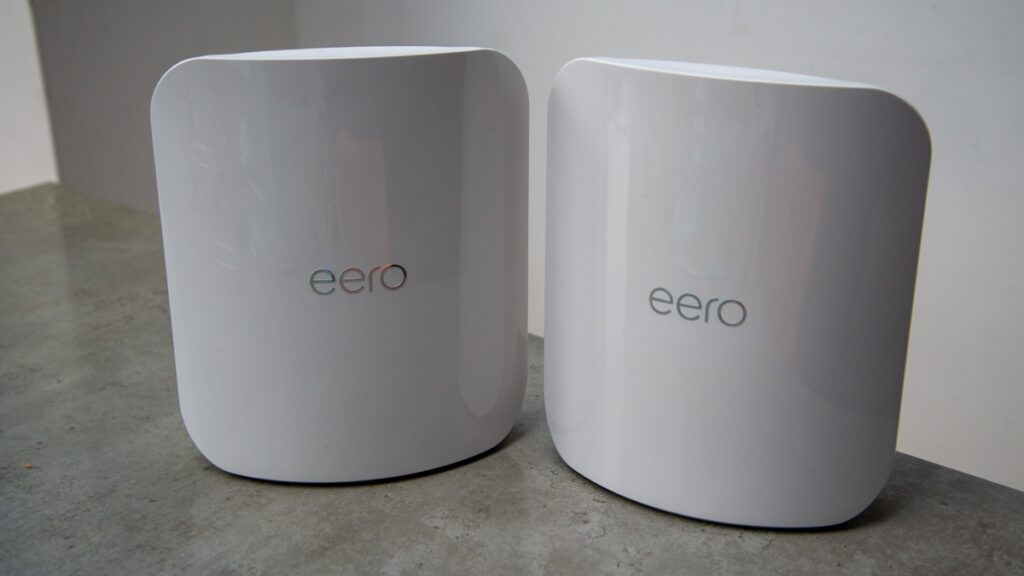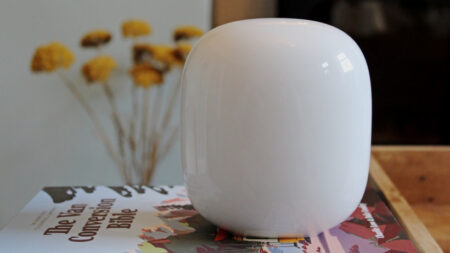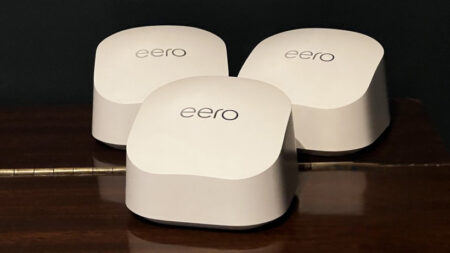Future proof mesh system with blazingly fast Wi-Fi 7 on offer
The price alone of this system ensures that it’s not for most people, and that’s alright. Rather than comparing this mesh system to what’s available, we must consider its merit and what it can do. Paired with Wi-Fi 7 devices, this system takes a huge leap forward in performance, offering speeds much faster than Gigabit Ethernet, and offering 10 Gigabit Ethernet speeds for LAN users. Firmly focussed on the future, this mesh system shows how wireless networking should be done. If you want stunning speeds today and a system that can cope with future demand, this is a stunning mesh system.
Pros
- Really fast with Wi-Fi 7
- Boosts Wi-Fi 6 performance
- Fast wired networking
- Simple app
Cons
- Expensive
- No web interface
- Downgrades when using older Eeros
At its big Devices and Services event back in September, Amazon took the covers off of the latest and greatest Eero system yet; the Wi-Fi 7 powered Eero Max 7.
It was less than a year ago that Wi-Fi 6E came out, promising wired Ethernet speeds via a 6GHz network and it’s fair to say that uptake of that particular technology has been slow and even Wi-Fi 6 isn’t yet ubiquitous.
Are we really ready for yet another new version of wireless connectivity with Wi-Fi 7 and Amazon’s new Eero Max 7?
Considering its eye-watering price (a three-pack Eero Pro 6E at $549.99 can be bought for less than a solitary $599.99 Eero Max 7), your initial thoughts may be that this is all a step too far, but look a little more closely at what Wi-Fi 7 is about, and it starts to make more sense.
Read next: Best mesh Wi-Fi systems
Rather than an iterative change, Wi-Fi 7 is a step-change in features and performance, which makes it far more suitable to ever-faster internet speeds and the increasing number of devices connected to home networks.
While the Eero Max 7 won’t be for all, those who demand the best and want a degree of future-proofing will like what it offers.
A single Eero Max 7 unit blankets an impressive 2,500 square feet, while a three-pack extends coverage to 7,500 square feet.
This is all made possible by Eero’s TrueMesh technology, which dynamically routes data through the fastest path in the network, minimizing interference and ensuring a consistently fast and reliable internet experience throughout your home.
This being Eero, it’s all backwards compatible too, you’ll be able to get the new Max 7 modules singing and dancing with your existing Eero kit (although you’ll obviously lose some features and speed if you mix and match with older generations).
Read our initial Eero Max 7 review for our first thoughts after living with the system for a couple of weeks.
We will update this review in a month or so to reflect further testing.
Eero Max 7: Setup and specs
Previous Eero devices have been relatively small, looking like keys plucked out of a giant’s keyboard. Taller and larger overall, the Eero Max 7 is far more like other mesh systems that I’ve reviewed, such as the Orbi RBKE963.
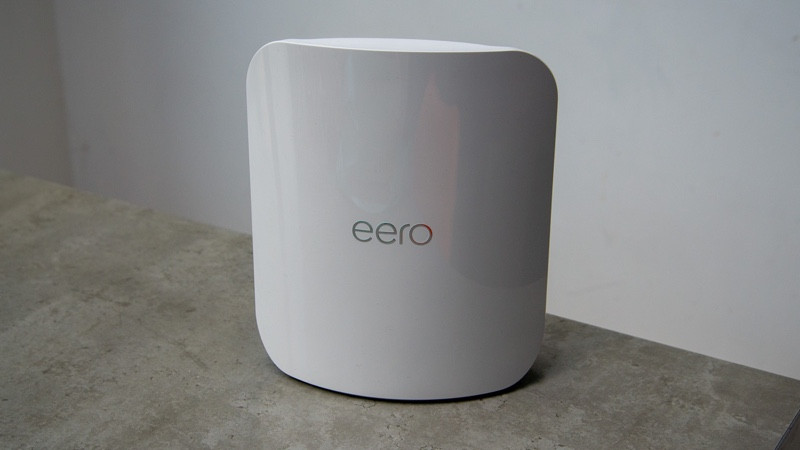
(Image credit: The Ambient)
A larger case does have its advantages, and this is the first Eero system to have more than two Ethernet ports, so you may be able to do away with additional network switches.
At the back of the satellite are four Ethernet ports: two 10 Gigabit Ethernet and two 2.5 Gigabit Ethernet.
That 10 Gigabit Ethernet port means, in theory at least as good luck finding an ISP that can match the pace, you could download a 4K movie in 10 seconds or a hefty 50GB game for your Xbox in less than a minute.
The Eero Max 7 supports 2.4, 5, and 6GHz radio bands, boasting wireless speeds of up to a whopping 4.3Gbps and wired speeds reaching up to 9.4Gbps.

(Image credit: The Ambient)
An Eero doesn’t distinguish between LAN and WAN ports, so either can be used with the gateway for your internet connection.
To get started, simply attach an Eero Max 7 satellite to your ISP’s modem, router or ONT via an Ethernet cable; there’s a swanky Cat6a one in the box you can use.
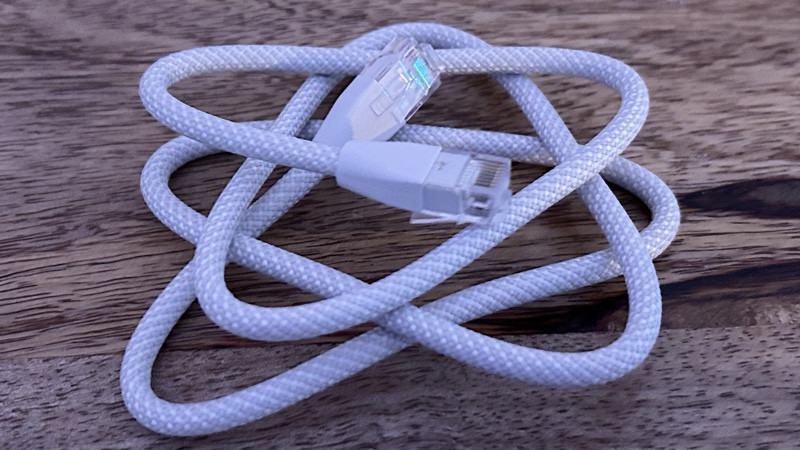
(Image credit: The Ambient)
By default the Eero you connect will become the Gateway Eero – essentially your router – although you do have the option of using the Eeros purely as access points but you’d be losing out on a lot of the features.
Be sure to check with your ISP what is possible with your current modem/router device; ideally you want one that can be put into modem-only (AKA bridge) mode, or even better still, bypassed entirely.
Once you’ve connected and powered up, just follow the simple steps in the Eero app to get your network up and running.
Only using one port for this connection leaves plenty of high-speed ports for a fast local network at home.

(Image credit: The Ambient)
That includes linking Eero Max 7 satellites together using a wired backhaul rather than relying on a wireless connection. There are good reasons to do this, and it’s not just about range (with a wired backhaul, you can place a satellite anywhere you need it).
Internally, the Eero Max 7 is a tri-band Wi-Fi device (2.4GHz, 5GHz and 6GHz), and shares its bandwidth between clients and inter-satellite communication. That can work well, but using an Ethernet backhaul means all Wi-Fi bandwidth is for clients.
As with previous Eero models, the Eero Max 7 is backwards compatible with previous Eero systems. It’s true that different systems work together, but mixing and matching isn’t always the best idea: if you do, then the Eero Max 7 may not be able to run at its optimum speeds.
One of the benefits of Wi-Fi 7 is that it can use 320MHz channels, up from 160MHz on Wi-Fi 6/6E. If you mix and match with older Eero devices, and you won’t get this option.
When I tried adding the Eero Max 7 to an existing Eero Pro 6E system, I found that my 6GHz network ran at 160MHz and my 5GHz network at 80MHz; installing the Eero Max 7 as a new system entirely, I got 320MHz 6GHz and 160MHz 5GHz.
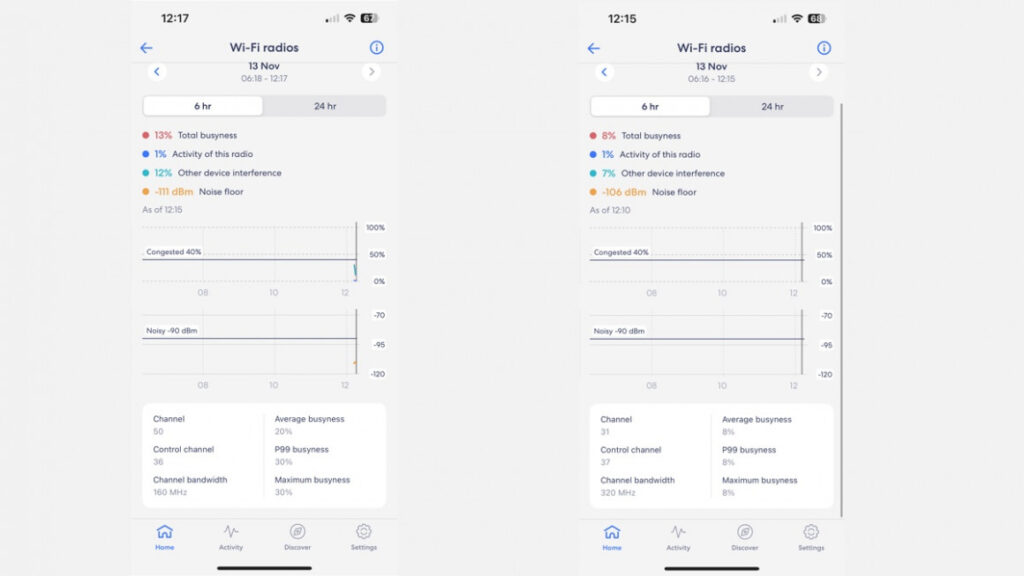
(Image credit: The Ambient)
Streams-wise, the Eero Max 7 has 2×2 2.4GHz, 4×4 5GHz and 4×4 6GHz networking, providing a total of 4.3Gbit/s of Wi-Fi throughput (up from 1.6Gbit/s on the Eero Pro 6E). Not that you should think of Wi-Fi 7 as individual blocks of spectrum.
Thanks to Multi-Link Operation (MLO), Wi-Fi 7 devices can connect on multiple frequencies at the same time to improve speeds. That is the real key to the speed improvements that Wi-Fi 7 promises.
Eero Max 7: Features
Managed via the Eero app, the Eero Max 7 is controlled entirely via the cloud with no local web interface. That means no advanced setting, such as the option to change the network channels, and you have to leave the system to pick what it thinks is best automatically.
There’s no option to split networks into individual bands, but given Wi-Fi 7’s MLO technology, you wouldn’t want to do this.

(Image credit: The Ambient)
What the Eero app does offer is pure simplicity. For free, you can create user profiles and assign devices to each person, scheduling when they can and can’t access the internet. If you want more, you need an Eero Plus subscription ($99.99/£99.99 annually).
This adds ad-blocking, web filtering, app blocking and subscriptions to three bits of software: Malware Bytes, 1Password and VPN powered by Guardian.
You also get the clever internet backup feature, where you can designate a second Wi-Fi network for the Eero system to connect to, should your Wi-Fi go down. This could be a friendly neighbour’s network or just a hotspot.

(Image credit: The Ambient)
For smart home users, there’s a Zigbee hub integrated, although it’s the inclusion of Thread that is more interesting, particularly with the rise of Matter, of which it can act as a controller and border router.
Amazon integration is built in, allowing for voice control. This still works better in the US, where there’s voice control over individual devices and the option to toggle the Guest network; here in the UK, I could pause a profile but that was it.
Eero Max 7: Performance
To see what the Eero Max 7 was capable of, I used it with a Xiaomi 13T Pro, which has Wi-Fi 7 built-in. I used the OpenSpeedTest server, running on a computer wired into a 10 Gigabit Ethernet port.
At close range, I saw average throughputs of 1895Mbit/s, which is the fastest throughput that I have seen from any wireless device ever.
Moving up to my second floor, where I had connected a second Eero Max 7 device, I saw throughputs of 1317Mbit/s, which is still crazily fast. On my second floor, speeds remained high at 1128Mbit/s. Overall, speeds at any range using Wi-Fi 7 were faster than I’ve seen from Wi-Fi 6E at close range.
Most of us don’t have Wi-Fi 7 devices, so I also tested with a Wi-Fi 6 iPhone 13 Pro. I saw speeds of 800Mbit/s at close range, 526Mbit/s on the first floor and 439Mbit/s on the second floor. These are all improvements over the speeds I get from an Eero Pro 6E system.
Additionally, we’ve been testing the Eero Max 7 with Virgin’s Gig1 service.
While the native VM Hub 4 and streaming pucks provided Wi-Fi speeds around my house at around 600-700Mbps from the theoretical max speed of 1,130Mbps, a pair of Eero Max 7 satellite devices ramped this up to 750-800Mbps.
Final thoughts
If you’re looking to future proof your home Wi-Fi setup then the Eero Max 7 could well be the, albeit expensive, answer.
The likes of Netgear’s flagship Orbi 970 Series is set to go live in the coming weeks and that’s bound to have network enthusiasts more excited, particularly as they can tinker more via a web interface, but for sheer ease of use and speed out of the box, the Eero Max 7 is going to be hard to beat.
Eero Max 7 Specs
| Wi-Fi Information | |
|---|---|
| Wifi standards | Wi-Fi 7 (IEEE802.11a/b/g/n/ac/ax/be) |
| Number of radios | 3; tri-band |
| Supported channels | 2.4 GHz: 1-13 5 GHz: 36-64, 100-144, 149-165 6 GHz: 1-233 |
| MIMO | 2×2/4×4/4×4 MU/SU-MIMO |
| Spatial streams | 10 |
| Channel width | 20, 40, 80, 160, 240, 320 MHz |
| Network security and services | WPA2-PSK, WPA3-Personal transition mode |
| Other Wi-Fi features | WMM, Tx Beamforming, OFDMA |
| Connectivity | |
| Smart home hub | Thread, Zigbee, Matter |
| Bluetooth | Bluetooth Low Energy 5.0 |
| Antenna | 2.4 GHz: 2×2 5 GHz: 4×4 6 GHz: 4×4 |
| Frequency bands | ISM (2.4-2.484 GHz) UNII 1: 5.15 – 5.25 GHz UNII 2A: 5.25 – 5.35 GHz UNII 2C: 5.47 – 5.725 GHz UNII 3: 5.725 – 5.850 GHz UNII 5: 5.925 – 6.425 GHz UNII 6: 6.425 – 6.525 GHz UNII 7: 6.525 – 6.875 GHz UNII 8: 6.875 – 7.125 GHz |
| Ethernet | Two auto-sensing 10 GbE ports and two auto-sensing 2.5 GbE ports for WAN and/or LAN connectivity |
| Hardware Specifications | |
| Processor | Quad-core A73 processor |
| Memory | 2GB RAM |
| Storage | 4GB flash storage |
| Size | 7.24 x 8.73 x 3.54 inches |


